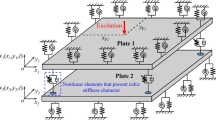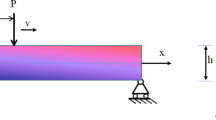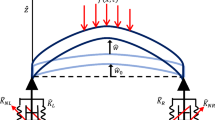Abstract
An analytical method for analyzing free vibration of multi-span Timoshenko beams under arbitrary boundary conditions is proposed in this paper. Based on the theoretical model of the Timoshenko beam, linear displacement springs and rotational springs are introduced to simulate the boundary and support forces of multi-span Timoshenko beams. By modifying the springs’ stiffness, different boundary conditions and inter-span coupling conditions can be simulated. To develop the vibration calculation models based on the energy method, the improved Fourier cosine series with four sine series are introduced to represent the displacement functions in order to eliminate the discontinuities or jumps in the solution processes. With the Rayleigh–Ritz method, the Lagrange equations of structures are solved to obtain free vibration characteristics. Using a three-span beam and a four-span beam as examples, this method is applied to calculate the natural frequencies of structures with circular and rectangular cross sections. The correctness and accuracy of the method are verified by comparing the solutions with the results of existing literature. On this basis, the influences of boundary conditions, span ratio and span number on the vibration characteristics of multi-span Timoshenko beams are discussed and analyzed.













Similar content being viewed by others
Data availability
The data used to support the findings of this study are available from the corresponding author upon request.
References
Cowper, G.R.: The shear coefficient in Timoshenko’s beam theory. J. Appl. Mech. 33(2), 335–340 (1964)
Han, S.M., Benaroya, H., Wei, T.: Dynamics of transversely vibrating beams using four engineering theories. J. Sound Vib. 225(5), 935–988 (1999)
Nelson, H.D.: A finite rotating shaft element using Timoshenko beam theory. J. Mech. Des. 102(4), 793–803 (1980)
Aydogdu, M.: A general nonlocal beam theory: its application to nanobeam bending, buckling and vibration. Phys. E Low Dimens. Syst. Nanostruct. 41(9), 1651–1655 (2009)
Reddy, J.N.: Nonlocal theories for bending, buckling and vibration of beams. Int. J. Eng. Sci. 45(2–8), 288–307 (2007)
Hutchinson, J.R.: Shear coefficients for Timoshenko beam theory. J. Appl. Mech. 68(1), 87–92 (2001)
Lee, S.J., Park, K.S.: Vibrations of Timoshenko beams with isogeometric approach. Appl. Math. Model. 37(22), 9174–9190 (2013)
Lee, S.S., Koo, J.S., Choi, J.M.: Variational formulation for Timoshenko beam element by separation of deformation mode. Commun. Numer. Methods Eng. 10(8), 599–610 (1994)
Civalek, O., Kiracioglu, O.: Free vibration analysis of Timoshenko beams by DSC method. Int. J. Numer. Method Biomed. Eng. 26(12), 1890–1898 (2010)
Lou, M.L., Duan, Q.H., Chen, G.: Modal perturbation method for the dynamic characteristics of Timoshenko beams. Shock Vib. 12(6), 425–434 (2005)
Zhou, D., Cheung, Y.K.: Vibrations of tapered Timoshenko beams in terms of static Timoshenko beam functions. J. Appl. Mech. 68(4), 596–602 (2001)
Liao, M., Zhong, H.: Nonlinear vibration analysis of tapered Timoshenko beams. Chaos Solitons Fractals 36(5), 1267–1272 (2008)
Xiang, H.J., Yang, J.: Free and forced vibration of a laminated FGM Timoshenko beam of variable thickness under heat conduction. Compos. B Eng. 39(2), 292–303 (2008)
Shafiei, N., Hamisi, M., Ghadiri, M.: Vibration analysis of rotary tapered axially functionally graded Timoshenko nanobeam in thermal environment. Solid Mech. 12(1), 16–32 (2020)
Civalek, Ö., Akbaş, ŞD., Akgöz, B., Dastjerdi, S.: Forced vibration analysis of composite beams reinforced by carbon nanotubes. Nanomaterials 11(3), 571 (2021)
Demir, Ç., Civalek, Ö.: On the analysis of microbeams. Int. J. Eng. Sci. 121, 14–33 (2017)
Numanoğlu, H.M., Ersoy, H., Akgöz, B., Civalek, Ö.: A new eigenvalue problem solver for thermo-mechanical vibration of Timoshenko nanobeams by an innovative nonlocal finite element method. Math. Methods Appl. Sci. 45(5), 2592–2614 (2022)
Akgöz, B., Civalek, Ö.: Buckling analysis of functionally graded tapered microbeams via Rayleigh–Ritz method. J. Math. 10(23), 4429 (2022)
Li, X.F.: A unified approach for analyzing static and dynamic behaviors of functionally graded Timoshenko and Euler–Bernoulli beams. J. Sound Vib. 318(4–5), 1210–1229 (2008)
Shahba, A., Attarnejad, R., Marvi, M.T., Hajilar, S.: Free vibration and stability analysis of axially functionally graded tapered Timoshenko beams with classical and non-classical boundary conditions. Compos. B Eng. 42(4), 801–808 (2011)
Esen, I.: Dynamic response of a functionally graded Timoshenko beam on two-parameter elastic foundations due to a variable velocity moving mass. Int. J. Mech. Sci. 153–154, 21–35 (2019)
Pradhan, K.K., Chakraverty, S.: Free vibration of Euler and Timoshenko functionally graded beams by Rayleigh–Ritz method. Compos. B Eng. 51, 175–184 (2013)
Nikrad, S.F., Kanellopoulos, A., Bodaghi, M., Chen, Z.T., Pourasghar, A.: Large deformation behavior of functionally graded porous curved beams in thermal environment. Arch. Appl. Mech. 91, 2255–2278 (2021)
Bourada, M., Kaci, A., Houari, M.S.A., Tounsi, A.: A new simple shear and normal deformations theory for functionally graded beams. Steel Compos. Struct. 18(2), 409–423 (2015)
Chen, D., Kitipornchai, S., Yang, J.: Nonlinear free vibration of shear deformable sandwich beam with a functionally graded porous core. Thin Walled Struct. 107, 39–48 (2016)
Ma, H.M., Gao, X.L., Reddy, J.N.: A microstructure-dependent Timoshenko beam model based on a modified couple stress theory. J. Mech. Phys. Solids 56(12), 3379–3391 (2008)
Zheng, D.Y., Cheung, Y.K., Au, F.T.K., Cheng, Y.S.: Vibration of multi-span non-uniform beams under moving loads by using modified beam vibration functions. J. Sound Vib. 212(3), 455–467 (1998)
EI-Sayed, T.A., EI Mongy, H.H.: A new numeric-symbolic procedure for vibrational literation method with application to the free vibration of generalized multi-span Timoshenko beam. J. Vib. Control 28(7–8), 799–811 (2022)
Fakhreddine, H., Adri, A., Rifai, S., Benamar, R.: A multimode approach to geometrically non-linear forced vibrations of Euler–Bernoulli multispan beams. J. Vib. Eng. Technol. 8(2), 319–326 (2020)
Dugush, Y.A., Eisenberger, M.: Vibrations of non-uniform continuous beams under moving loads. J. Sound Vib. 254(5), 911–926 (2002)
Abu-Hilal, M.: Forced vibration of Euler–Bernoulli beams by means of dynamic Green functions. J. Sound Vib. 267(2), 191–207 (2003)
Luo, J., Zhu, S., Zhai, W.: Exact closed-form solution for free vibration of Euler–Bernoulli and Timoshenko beams with intermediate elastic supports. Int. J. Mech. Sci. 213, 106842 (2022)
Zhao, X., Chen, B., Li, Y.H., Zhu, W.D., Nkiegaing, F.J., Shao, Y.B.: Forced vibration analysis of Timoshenko double-beam system under compressive axial load by means of Green’s functions. J. Sound Vib. 464(1), 115001 (2020)
Ghannadiasl, A., Ajirlou, S.K.: Forced vibration of multi-span cracked Euler–Bernoulli beams using dynamic Green function formulation. Appl. Acoust. 148, 484–494 (2019)
Zhu, L., Elishakoff, I., Lin, Y.K.: Free and forced vibrations of periodic multispan beams. Shock Vib. 1(3), 217–232 (1994)
Lin, H.P., Chang, S.C.: Free vibration analysis of multi-span beams with intermediate flexible constraints. J. Sound Vib. 281(1–2), 155–169 (2005)
Jin, Y., Yang, R., Liu, H., Xu, H., Chen, H.: A unified solution for the vibration analysis of lattice sandwich beams with general elastic supports. Appl. Sci. 11(19), 9141 (2021)
Jin, Y., Luo, X., Liu, H., Qiu, B., Chi, H.: An accurate solution method for vibration analysis of multi-span lattice sandwich beams under arbitrary boundary conditions. Thin Walled Struct. 175, 109214 (2022)
Lin, H.Y., Tsai, Y.C.: Free vibration analysis of a uniform multi-span beam carrying multiple spring–mass systems. J. Sound Vib. 302(3), 442–456 (2007)
Yesilce, Y., Demirdag, O.: Effect of axial force on free vibration of Timoshenko multi-span beam carrying multiple spring–mass systems. Int. J. Mech. Sci. 50(6), 995–1003 (2008)
Yesilce, Y.: Effect of axial force on the free vibration of Reddy–Bickford multi-span beam carrying multiple spring–mass systems. J. Vib. Control 16(1), 11–32 (2010)
Yesilce, Y.: Free vibrations of a Reddy–Bickford multi-span beam carrying multiple spring–mass systems. Shock Vib. 18(5), 709–726 (2011)
Yesilce, Y.: Differential transform method and numerical assembly technique for free vibration analysis of the axial-loaded Timoshenko multiple-step beam carrying a number of intermediate lumped masses and rotary inertias. Struct. Eng. Mech. 53(3), 537–573 (2015)
Borji, A., Movahedian, B., Boroomand, B.: Implementation of time-weighted residual method for simulation of flexural waves in multi-span Timoshenko beams subjected to various types of external loads: from stationary loads to accelerating moving masses. Arch. Appl. Mech. 92(4), 1247–1271 (2022)
Liu, L., Yang, W., Chai, Y., Zhai, G.: Vibration and thermal bucking analyses of multi-span composite lattice sandwich beams. Arch. Appl. Mech. 91(6), 2601–2616 (2021)
Gao, C., Pang, F., Li, H., Wang, H., Cui, J., Huang, J.: Free and forced vibration characteristics analysis of a multispan Timoshenko beam based on the Ritz method. Shock Vib. 2021, 1–18 (2021)
Xu, S., Wang, X.: Free vibration analyses of Timoshenko beams with free edges by using the discrete singular convolution. Adv. Eng. Softw. 42(10), 797–806 (2011)
Shi, D., Wang, Q., Shi, X., Pang, F.: An accurate solution method for the vibration analysis of Timoshenko beams with general elastic supports. Proc. Inst. Mech. Eng. Part C J. Mech. Eng. Sci. 229(13), 2327–2340 (2015)
Wang, R.T.: Vibration of multi-span Timoshenko beams to a moving force. J. Sound Vib. 207(5), 731–742 (1997)
Chen, G., Zeng, X., Liu, X., Rui, X.: Transfer matrix method for the free and forced vibration analyses of multi-step Timoshenko beams coupled with rigid bodies on springs. Appl. Math. Model. 87, 152–170 (2020)
Copetti, R.D., Claeyssen, J.R., Tolfo, D.D.R., Pavlack, B.S.: The fundamental modal response of elastically connected parallel Timoshenko beams. J. Sound Vib. 530, 116920 (2022)
Zhao, Z., Wen, S., Li, F., Zhang, C.: Free vibration analysis of multi-span Timoshenko beams using the assumed mode method. Arch. Appl. Mech. 88(7), 1213–1228 (2018)
Bao, S.Y., Zhou, J.: Vibrational characteristics of a multi-span beam with elastic transverse supports of different shaped sections. Chin. J. Ship Res. 15(1), 162–169 (2020)
Li, W.L.: Free vibrations of beams with general boundary conditions. J. Sound Vib. 237(4), 709–725 (2000)
Acknowledgements
This study was supported by the Key Research and Development program of Shandong Province, China (2022CXGC020509), Fundamental Research Funds for the Central Universities (3072022QBZ2701), Strategic Rocket Innovation Fund (ZH2022009), the program of Yantai Growth Drivers Conversion Research Institute and Yantai Science and Technology Achievement Transfer and Transformation Demonstration Base (YTDNY20220425-01).
Author information
Authors and Affiliations
Contributions
YJ proposed the research concept, managed the research project, obtained research funding, and reviewed and revised the paper. YJ and YL worked on the program together. YL analyzed and organized the resulting data, visualized the results, and wrote the first draft of the paper. DY and FZ verified the design and results. XL and PZ participated in the relevant part of the background research. All authors have reviewed the manuscript.
Corresponding author
Ethics declarations
Conflict of interest
The authors declare that they have no competing financial interests or personal relationships that could have appeared to influence the work reported in this paper.
Additional information
Publisher's Note
Springer Nature remains neutral with regard to jurisdictional claims in published maps and institutional affiliations.
Appendix
Appendix
According to the above theoretical derivation process, if the span number is N, and the highest number of terms in the improved Fourier series is M, then the dimension unknown coefficient vector A in Eq. (19) is [2(M + 5) × N] × 1, the specific formula is expressed as follows:
Similarly, for an N-span Timoshenko beam, its overall mass matrix \({\mathbf{M}}\) and stiffness matrix \({\mathbf{K}}\) are both [2(M + 5) × N] × [2(M + 5) × N] order matrices. Thus, the specific formulas of the overall mass matrix \({\mathbf{M}}\) and stiffness matrix \({\mathbf{K}}\) in Eq. (19) are expressed as follows:
where \({\mathbf{K}}_{P}\), \({\mathbf{K}}_{S}\) and \({\mathbf{K}}_{C}\) are all [2(M + 5) × N] × [2(M + 5) × N] order matrices.
where \({\mathbf{K}}_{i,P}\) is 2(M + 5) × 2(M + 5) order matrices, its specific formula is expressed as follows:
where \({\mathbf{K}}_{i,S}\) is 2(M + 5) × 2(M + 5) order matrices, its specific formula is expressed as follows:
where \({\mathbf{K}}_{i,C}^{11}\), \({\mathbf{K}}_{i,C}^{12}\), \({\mathbf{K}}_{i,C}^{21}\), \({\mathbf{K}}_{i,C}^{22}\) are all 2(M + 5) × 2(M + 5) order matrices, its specific formula are expressed as follows:
where \(r,k = 1,2, \ldots ,M\); \(s,j = 1,2,3,4\); \(i = 1,2, \ldots ,N\).
Rights and permissions
Springer Nature or its licensor (e.g. a society or other partner) holds exclusive rights to this article under a publishing agreement with the author(s) or other rightsholder(s); author self-archiving of the accepted manuscript version of this article is solely governed by the terms of such publishing agreement and applicable law.
About this article
Cite this article
Jin, Y., Lu, Y., Yang, D. et al. An analytical method for vibration analysis of multi-span Timoshenko beams under arbitrary boundary conditions. Arch Appl Mech 94, 529–553 (2024). https://doi.org/10.1007/s00419-023-02534-w
Received:
Accepted:
Published:
Issue Date:
DOI: https://doi.org/10.1007/s00419-023-02534-w




